How Website Design Impacts Brand Perception and Trustworthiness
How Website Design Impacts Brand Perception and Trustworthiness
Blog Article
The Ultimate Overview to Modern Internet Site Style Trends
In the ever-evolving electronic landscape, modern site style fads play a critical function in shaping customer experience and involvement. From the surge of minimalist layout concepts that focus on simplicity to the effect of strong typography in defining brand name identification, each component contributes to a natural on the internet visibility.
Minimalist Layout Principles
Minimalist style principles emphasize the idea that less is extra, supporting for simpleness and functionality in aesthetic communication. This method remove unnecessary elements, concentrating rather on vital elements that share the desired message effectively. By prioritizing quality, minimal layout improves user experience, allowing visitors to browse web sites effortlessly.
Core tenets of minimalist layout consist of the use of enough white room, which produces a sense of equilibrium and organization. This unfavorable space not only directs the audience's focus to crucial elements however additionally fosters a calming visual ambience. Additionally, a limited shade palette is frequently utilized, using single schemes or soft shades to keep aesthetic cohesion and stop overwhelming the user.
Typography plays an essential function in minimal design, where legible font styles are selected for their simplicity and performance in connecting material. Pictures and graphics are used moderately, ensuring that they offer a purpose as opposed to distract from the general message. Eventually, minimalist layout concepts grow a focused atmosphere that motivates users to engage with the content, boosting the general performance of modern-day site style. This pattern mirrors a growing recognition for thoughtful, user-centric appearances in electronic spaces.
Vibrant Typography Choices
Embracing strong typography choices has actually come to be a defining attribute of contemporary web site design, as it efficiently captures interest and shares solid messaging. Developers are increasingly making use of typography not just as a functional element yet as a key visual component that boosts the total visual and customer experience.

Additionally, the juxtaposition of strong typography with minimal style principles permits for striking contrasts, improving readability while preserving visual allure. Making use of whitespace around strong message further emphasizes its significance, making certain that the message resonates with the audience.
As electronic landscapes come to be a lot more affordable, leveraging bold typography allows brands to separate themselves and leave a long-term impression. The careful choice of typefaces and their application can evoke emotions, establish tone, and drive activity, making strong typography an essential tool in modern-day web site layout. Inevitably, it is an effective way to improve narration and make sure that crucial messages are not just seen but also felt.
Mobile-first and receptive Layout
Receptive and mobile-first layout has become an important principle in contemporary website development, mirroring the raising dependence on smart phones for accessing on the internet web content. As user actions changes in the direction of mobile surfing, designers should prioritize creating experiences that adapt flawlessly throughout numerous screen sizes and resolutions.
A responsive style makes sure that an internet site instantly readjusts its layout, images, and capability based on the device being used. This strategy enhances customer experience by supplying regular navigating and readability, regardless of whether the site visitor is on a desktop, tablet computer, or mobile phone computer. In addition, mobile-first design advocates for developing web sites originally for smaller screens, consequently scaling approximately larger displays. This technique motivates an extra reliable and streamlined style process, focusing on necessary material and performance initially.
Carrying out mobile-first and responsive concepts not only satisfies customer choices yet also aligns with search engine optimization (SEARCH ENGINE OPTIMIZATION) techniques. Significant search engines, like Google, prioritize mobile-friendly sites in their rankings, making it crucial for organizations to take on these design techniques. In an affordable digital landscape, embracing mobile-first and responsive design is not simply an option; it is crucial for guaranteeing access and engagement with a diverse audience.
Involving Microinteractions
Microinteractions play a crucial function in boosting individual engagement and overall website experience, particularly in the context of mobile-first and responsive design. These subtle style elements supply prompt feedback to users, making interactions much more instinctive and pleasurable. Instances include switch computer animations, notice notifies, and packing signs, which not only guide individuals yet additionally create a feeling of link with the interface.
Incorporating engaging microinteractions can significantly boost functionality by minimizing cognitive load. When users receive aesthetic or auditory comments upon carrying out activities, such as clicking a switch or submitting a form, they feel extra confident in their choices. This fosters a smoother navigation experience, ultimately increasing individual retention.

As website style patterns continue to develop, the importance of microinteractions can not be overstated. They function as the subtle yet powerful touchpoints that article source transform regular communications their explanation right into remarkable experiences, consequently boosting the total efficiency of contemporary web layout.
Lasting Internet Layout Practices
Lasting web design methods are becoming progressively crucial as the electronic landscape grows and environmental worries rise. Programmers and designers are identifying their duty to create websites that not only offer user needs however also minimize environmental effect. This technique includes a number of crucial approaches.
First of all, optimizing power intake is paramount. Internet sites ought to be designed to fill quickly and successfully, which decreases server power use and improves individual experience. Strategies such as picture compression, decreasing HTTP demands, and utilizing modern coding techniques contribute considerably to this objective.
Secondly, selecting eco-friendly holding companies is essential - website design. Lots of organizing companies are now powered by renewable resource resources, allowing internet sites to operate in a more lasting manner. This choice shows a dedication to lowering carbon footprints
Additionally, taking on a minimal design can enhance sustainability. Fewer components on a web page bring about much less data transfer, which not only accelerates loading times yet also conserves resources.
Finally, promoting digital access makes certain that sites get to a bigger target market without unneeded bloat, lining up individual experience with ecological responsibility. By incorporating these sustainable techniques, web developers can contribute favorably to both customer involvement and the world's well-being.
Verdict
In recap, contemporary web site style trends emphasize the combination of minimal principles, vibrant typography, and responsive design to enhance user experience. Embracing these patterns is crucial for producing impactful digital experiences that reverberate with individuals in a significantly competitive on the internet landscape.
In the ever-evolving digital landscape, contemporary site layout trends explanation play a vital function in shaping customer experience and involvement. By focusing on quality, minimal design boosts individual experience, enabling visitors to browse internet sites effortlessly.
Ultimately, minimal design concepts cultivate a focused setting that motivates individuals to engage with the content, boosting the total effectiveness of modern-day site design.Microinteractions play a crucial role in enhancing individual involvement and overall site experience, especially in the context of mobile-first and receptive style.In summary, contemporary web site style trends highlight the combination of minimal principles, vibrant typography, and responsive design to boost user experience.
Report this page